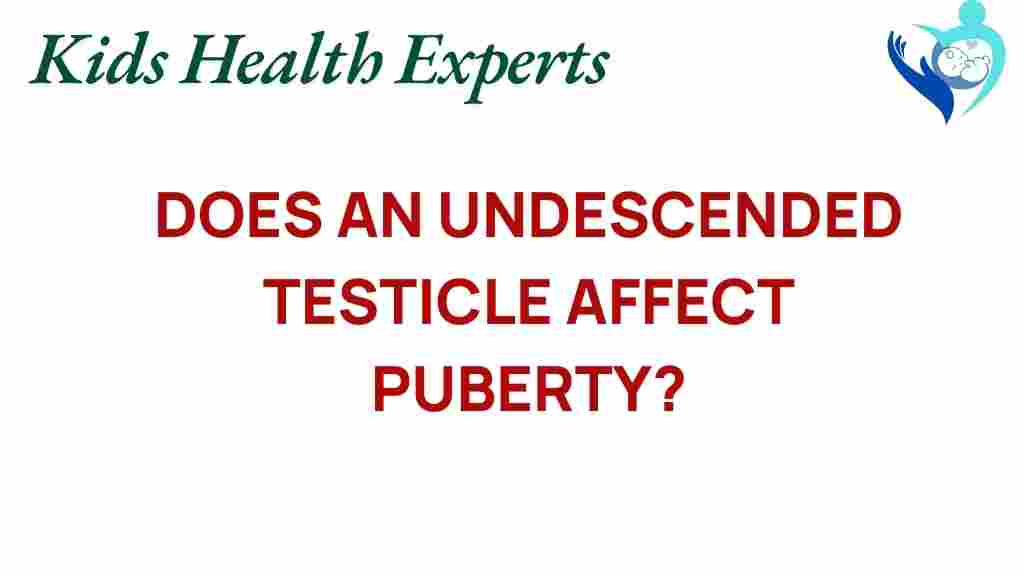The Hidden Impact of an Undescended Testicle on Puberty
Puberty is a significant stage in male development, marked by various physical, emotional, and hormonal changes. However, certain childhood conditions can impact this critical period, one of which is an undescended testicle. This article will explore the effects of an undescended testicle on puberty, hormone levels, fertility, and the necessary medical interventions involved. Understanding these implications is crucial for parents, caregivers, and young men navigating puberty.
Understanding Undescended Testicle
An undescended testicle, or cryptorchidism, occurs when one or both testicles fail to descend into the scrotum before birth. This condition affects approximately 3-4% of newborn boys and can have long-term implications if not addressed promptly.
How Undescended Testicle Affects Puberty
The impact of an undescended testicle on puberty can be profound, influencing various aspects of male development:
- Hormone Levels: An undescended testicle can affect the production of testosterone, the primary male sex hormone, which is crucial for the development of secondary sexual characteristics during puberty.
- Fertility: If left untreated, an undescended testicle may lead to fertility issues later in life due to impaired sperm production and quality.
- Health Risks: Men with a history of undescended testicles have a higher risk of developing testicular cancer, especially if the condition persists into adulthood.
Hormonal Changes During Puberty
During puberty, boys experience a surge in testosterone levels, which facilitates various changes such as:
- Growth of facial and body hair
- Deepening of the voice
- Increased muscle mass and strength
- Development of sexual organs
For boys with an undescended testicle, the testosterone production might be compromised, leading to:
- Delayed onset of puberty
- Reduced development of secondary sexual characteristics
- Potential emotional and psychological effects due to differences in physical appearance compared to peers
Potential Health Risks
In addition to affecting hormone levels, an undescended testicle can pose several health risks:
- Infertility: The undescended testicle may not function correctly, leading to reduced sperm production.
- Testicular Cancer: The risk of developing testicular cancer is significantly higher in individuals with a history of cryptorchidism.
- Inguinal Hernia: There is an increased risk of hernias, especially if the testicle is located in the inguinal canal.
Medical Intervention for Undescended Testicle
Early diagnosis and intervention are crucial for minimizing the risks associated with an undescended testicle. Here’s a step-by-step process for addressing this condition:
Step 1: Diagnosis
Typically diagnosed during routine physical examinations, doctors may employ methods such as:
- Physical examination by a pediatrician or urologist
- Ultrasound imaging to locate the undescended testicle
Step 2: Monitoring
In some cases, if the testicle descends on its own within the first few months after birth, no further action may be necessary. However, if it remains undescended, further intervention is needed.
Step 3: Surgical Intervention
For persistent cases, surgical intervention, known as orchidopexy, is often the recommended course of action. This procedure typically involves:
- Locating the undescended testicle
- Positioning it correctly within the scrotum
- Securing it to prevent retraction
Orchidopexy is usually performed between six months and one year of age to minimize the risks associated with an undescended testicle.
Step 4: Postoperative Care
Following surgery, parents should monitor the child for:
- Signs of infection (redness, swelling, fever)
- Pain management and recovery
- Follow-up appointments with a urologist
Long-Term Monitoring
Even after surgical intervention, it is essential to monitor the child’s development throughout puberty. Regular check-ups with a urologist can help assess:
- Testosterone levels
- Physical development milestones
- Fertility potential in later years
Troubleshooting Common Concerns
Parents and caregivers may have several concerns regarding an undescended testicle, especially during puberty. Here are some troubleshooting tips:
Concern 1: Delayed Puberty
If puberty appears delayed:
- Consult a urologist for evaluation of hormone levels.
- Discuss potential interventions such as hormone therapy if necessary.
Concern 2: Emotional and Psychological Impact
It’s common for boys to feel self-conscious about physical differences:
- Encourage open communication about feelings and experiences.
- Consider counseling or support groups for emotional support.
Concern 3: Fertility Questions
As boys transition into young adulthood, fertility concerns may arise:
- Discuss sperm banking options before any necessary medical treatments.
- Regular semen analysis may be advised to assess fertility.
Conclusion
In summary, an undescended testicle can significantly impact puberty and male development, influencing hormone levels, fertility, and overall health risks. Early diagnosis and medical intervention are crucial to mitigate these effects and promote healthy development. Parents and caregivers should remain vigilant about the potential challenges and communicate openly with healthcare professionals. Regular follow-ups with a urologist can ensure that any arising issues are addressed promptly, paving the way for a healthy transition into adulthood.
For more information about male reproductive health, visit the American Urological Association. If you have concerns about your child’s development, consult a pediatric urologist or healthcare provider specialized in childhood conditions.
This article is in the category Conditions and created by KidsHealthExperts Team
